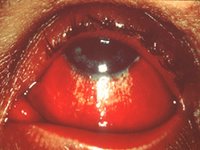
Below are some pearls taken from
Arthritis as Seen Through the Eyes in January 2006 Review of Optometry·
Symptoms of RA: stiffness in multiple joints, morning stiffness in the joints for more than one hour and generalized fatigue.
Clinical signs of RA include joint swelling and tenderness.
·
Lab Testing for RA includes CBC (shows normochromic-normocytic anemia in 80% of cases, ESR & C-reactive protein, and Rheumatoid Factor (RF).
· At
plaquenil follow-ups perform color vision testing, photodocumentation of the macula and automated perimetry of central vision (e.g., Humphrey central 10-2) every six months to one year.
·
Ocular complications of RA include Keratoconjunctivitis sicca (KCS), episcleritis, scleritis, keratitis and peripheral corneal. Retinal detachment, choroiditis, episcleral nodules, retinal vasculitis and cystoid macular edema have also been associated with RA.
· You may need to educate the comanaging rheumatologist that liver enzymes do not need to be monitored when patients use
Restasis.
·
Omega-3 essential fatty acid supplements, derived from various fish and plant sources, may alleviate dry eye symptoms by decreasing prostaglandin production.
· Therapeutic contact lenses can also be used to treat patients who have recalcitrant
filamentary keratitis.
· Hyperemia usually blanches with topical phenylephrine in patients who have
episcleritis but not in those who have
scleritis.
· Palpation of the globe often elicits marked tenderness in patients who have scleritis, but generally not in those who have episcleritis.
· We typically treat
episcleritis in RA patients for four weeks with indomethacin 25mg q.i.d. and taper to t.i.d once we note improvement.
 British Journal of Ophthalmology 2006;90:29-32
British Journal of Ophthalmology 2006;90:29-32